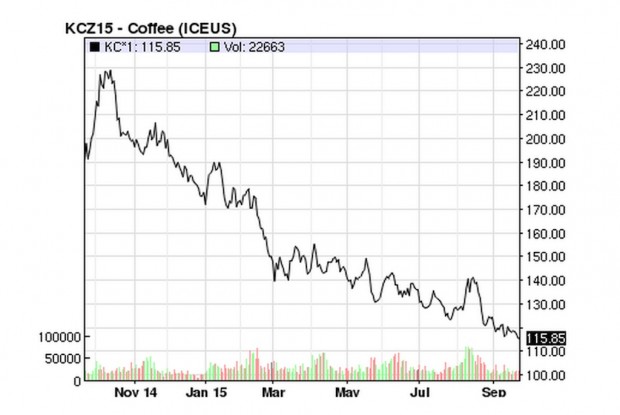
Data showing the price of C coffee for the past year, ending at a low of $1.158 per pound on Sept. 16, from the ICE US Futures Exchange.
My mother is a first generation immigrant. She came to the United States with my father and three small children in the mid 1980s from the Philippines. Like many first generation immigrants, she knows the value of a dollar and she rarely pays retail price for anything. A coupon or a sale can always be found. And if prices dropped on something that she had already bought? Well, she could always return the item and re-purchase it at the new, low price.
The generous return policies at stores in the United States are my mother’s mitigation against the risk that the item in question could have been bought at a cheaper price. Relatively, the true financial risk my mother faces by paying a bit more for a gallon of milk is really small. The price drop will be measured in cents and it’s a really minor purchase for the household.
For a coffee farmer whose livelihood depends on the sale of their crop, a price drop of cents in the global price of coffee can be the difference between just-getting-by and a successful year.
Smallholder farmers face enormous risks due to the volatile price of coffee. A farmer, selling her coffee, unaware of what the global price is, or where the price is trending, or what causes the macro-level changes in prices is often at the mercy of the market. She is a price taker and with definitely less generous return policies than my mother is getting.
A few months ago, the World Bank released a new report on the coffee sector that caught my attention. Titled “Risk and Finance in the Coffee Sector: A Compendium of Case Studies Related to Improving Risk Management and Access to Finance in the Coffee Sector,” it takes a look at the challenges facing the coffee sector through the lens of risk and risk management. I wrote about it in a previous post that addressed the unequal investment in the retail side of the supply chain compared to the production side — a direct result of the lopsided and imbalanced exposures to risk.
Coffee farming is filled with risks: climate change, El Niño, depreciating currencies, roya. I think we have a good understanding of how, and to what extent, we can mitigate risks from the production side. However, we need to understand that not all farmers have the means or methods available to deal with production risks. There is still insufficient knowledge of good farm management practices to prepare for droughts or to manage an outbreak of roya.
The risk faced by farmers due to price can be just as devastating as roya or El Niño, causing losses that take years to recover from. Today’s price (September 16) is $1.16 — the NYC “C” price is one of the benchmarks used to serve as the base for many producers. They have little to do with the depreciation of the Brazilian real or Colombian Peso. Yet, unfortunately, their product’s price is tied to this index. (Mark Lundy has some particularly valuable insights into how specialty coffee pricing relates to the commodity coffee price.)
This price is barely above the cost of production in Central America — a rough estimate for Central America is $1.00 to $1.10 USD per pound, including the farmers’ own labor. As we enter the 2015/16 harvest in Central America, I know that all the farmers are nervously looking at the price and praying it comes up.
While the knowledge and methods to mitigating the production risks are becoming a more discussed topic, rarely do we get into discussions of mitigating price risk. Our friends at Fairtrade USA, Keurig Green Mountain, Intl FC Stone, Twin Trading and Sustainable Harvest are some exceptions to this. They have been some of the first to discuss how to create Price Risk Management (PRM) tools that work for farmers and cooperatives as well as traders. Price risk management refers to strategies for farmers to minimize their risk to the volatility in prices. Rather than having enormous swings in profitability/loss, the producer or producer organization can have a more stable income and be able to plan financially. A popular misconception of PRM is that it is exclusively the domain of well financed and organized groups who are able to utilize the futures market.
How might a PRM strategy look different for an estate vs. a cooperative? What are some more basic methods of managing more simple tools? I’m going to be exploring these topics over the next few posts through interviews with some experts and folks who are taking steps to ensure that farmers and farmer organizations are better protected.
Kraig Kraft
Kraig Kraft is the CRS Technical Advisor for Coffee and Cacao for the Latin America/Caribbean. He is Based in Managua.
Comment
1 Comment
Comments are closed.






Kraig, Parabéns. I like the idea of this post series a lot. I am right now in Belo Horizonte, at the Semana Internacional do Café, and the low price level is discussion topic number 1 among producers. Looking very much forward to reading the different points of view, strategies and PRM tools. Abraço Raphael